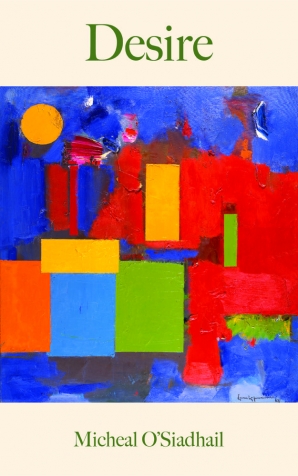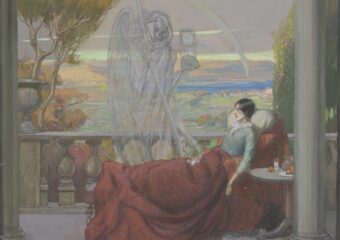Micheal O’Siadhail
Waco, Tx
Baylor University Press
2023
111 pages
According to the Art:
In considering how we should respond to the Covid-19 pandemic and harms produced from environmental destruction and digital capitalism, O’Siadhail, through his poetry, asks that we consider more than just what lessons we have learned, and consider what we should desire.
Synopsis:
In 2018, Micheal O’Siadhail (pronounced mee-hawl o’sheel) published The Five Quintets, the result of a decade spent discerning four centuries of modern Western thought across many fields. He looked for the wisdom it offers current-day life, and expressed his learnings poetically. While working on a follow up to the book, which was to be an accounting of more immediate threats to civilization, a sudden and unexpected threat emerged—the Covid-19 pandemic. O’Siadhail decided the pandemic needed to be included in his account of current crises threatening civilization.
The more I thought about this time of the Coronavirus, the more it bore in on me that it was a crisis inextricably and complexly interlinked with the other two major, looming crises which had previously absorbed me—the destruction of the planet and rampant capitalism of the digital age.
p. xiii
Accountings after lacerating events like the Covid-19 pandemic often take the shape of technocratic reactions to “lessons learned,” such as upgrading surveillance methods and warning systems for emerging infectious threats; developing operational plans for rapid responses to epidemics and pandemics; creating counterprogramming for disinformation campaigns; and implementing mechanisms for rapid development and deployment of medical equipment and pharmaceutical products, among others. O’Siadhail’s accounting, however, is instead on a different plane, a higher plane; it is a reckoning with our desires, which themselves play a large role in determining our fates.
In light of all that people have suffered during this pandemic, any reassessment of our values, any pondering of our age must ask: what is worthy of our desire? The ultimate question in our frail and passing human lives must be: what do we desire?
p. xiv
This reckoning becomes the primary pursuit of the book. It comprises four main sections—Pest, Habitat, Behind the Screen, and Desiring. The section headings describe the specific issues O’Siadhail covers, that is, the damage Covid, environmental destruction, and digital capitalism wreak, and the reconciliation of our desires with these threats. Each section has twenty-five poems, making a total 100 in the book. All of which builds and pushes us towards thinking and rethinking about our desires and how they affect our world.
Where to now? We know we can’t return To old greeds that play with nature’s fire— Never such an urgent need to learn How to shape our world with new desire. ((i); p. 108)
Analysis:
The Covid-19 pandemic accelerated O’Siadhail’s already-urgent pursuit of ongoing threats, and motivated him to integrate the pandemic into the endeavor. He argues that each of these threats individually, and most certainly in combination, should make us think about our desires. In making these arguments, he takes each threat apart and identifies where and how it conspires against current civilization.
My primary interest for this blog is the value particular works from any of the humanities genres bring a better understanding of specific clinical scenarios or health care situations offered through biomedical texts and teachings alone. So, I focus here on how O’Siadhail enhances our grasp of the Covid-19 pandemic, and draw excerpts from a few of the aspects, not all, he considers.
Beyond the specific aspects of Covid-19 O’Siadhail addresses, the poetic forms he uses themselves contribute to his cause. The writer and poet, Sharon Van Sluijs, offers a way to understand how this might work.
Poetry, often, is a beautiful, complex, and thoughtful argument…Poetry as a form uses language to make connections — at times extravagantly surprising connections through syntax, sound, and meter — that prosaic language communicating data does not.
The form of poems often contributes to ideas and thoughts poets want to convey. O’Siadhail uses a different form for the poems in each of the four sections. He may be calling attention to the differences among issues each section takes on. Also, in each of the four sections, most of the lines are in iambic pentameter modified such that the lines have nine syllables rather than the usual ten. With the loss of one syllable, O’Siadhail may be signaling a sense of loss accompanying Covid and the other threats he covers.
Was our susceptibility to the pandemic as a population of our own faults, or of our own frailty, are questions O’Siadhail considers: “So easy to forget what we know / How our frail humanity is one.” The way individuals became susceptible to SARS-CoV-2, clinically, also captures his attention, and his poetic explanation of how the virus spreads shows the value of “syntax, sound, and meter” when compared to the classic “prosaic” biomedical text. Here’s an excerpt from Harrison’s Principals of Internal Medicine:
Spread of SARS-CoV-2 is believed to be primarily via respiratory droplets transmitted between persons in proximity when the droplets make direct contact with mucous membranes. Airborne transmission by small particle from person-to-person may occur, but airborne transmission over long distances is unlikely…The onset of disease is manifest typically within 4–5 days after exposure and nearly always within 14 days.*
Here’s O’Siadhail’s poetic version:
Cunning spy invading our airspace, Undercover agent who’d access All our need to touch and to embrace, Catching us off guard in one caress. Even in our talk it could begin Hiding droplets in the spray of tongues, In our words the enemy within Bent on colonising others’ lungs. Clever virus spreading still lay low Several days allowing us pass on What we’ve had and didn’t even know, Making us its covert liaison. Multiplying secretly in you, Covid played its game of peekaboo. (5 (A); p. 8)
This poetic version of viral spread augments the biomedical textbook version in its “beautiful, complex, and thoughtful” description, by accentuating certain properties of the virus with metaphors (e.g., “undercover agent”) and conjuring emotional images (e.g., “embrace,” “caress”). The importance of the stealth nature of viral spread and the implications of it come across with a greater emphasis, leaving a more lasting impression than the turgid text of biomedical sources could.
The comparison of how directly related biomedical and poetic text can be is shown below.
| Biomedical Text | Poetic Text |
| Spread of SARS-CoV-2 is believed to be primarily via respiratory droplets transmitted between persons in proximity when the droplets make direct contact with mucous membranes. | Even in our talk it could begin Hiding droplets in the spray of tongues, In our words the enemy within Bent on colonising others’ lungs. |
| The onset of disease is manifest typically within 4–5 days after exposure and nearly always within 14 days. | Several days allowing us pass on What we’ve had and didn’t even know, Making us its covert liaison. Multiplying secretly in you, Covid played its game of peekaboo. |
Spread this virus did, and O’Siadhail notes how it put much of the world on a war footing: “Beds and gurneys crowded on each floor, / New field hospitals, posts heads assign / Medicine embraced war’s metaphor—“. He also notes how the resulting scarcity forced difficult decisions: “Breathless, suffocating multiply— / Ventilators scarce, how then to choose / Who to help and who they should let die,”. (5 (B); p. 8)
O’Siadhail pays a lot of attention to how the pandemic effects lives, and in this way, he is expanding on biomedical texts rather than augmenting them. For example, all lives were disrupted in some way, and he depicts some of them:
Disappointments, things postponed, chagrin, Dreams so many had to then let go; Know there was no point in living in Past subjunctives ‘if it weren’t so.’ (8 (B); p. 11) ---------------------------------------------- Those who hold economies in flight, Grounded, watched their businesses collapse, No next plane to catch, no end in sight, Watched as time refused to elapse. (22 (B); p. 25)
The lockdowns that we knew could be a blessing or a curse, he portrays as, “Dramas acted out behind closed doors, / Living hell or honeymoon encores.” (19 (B); p. 22) But, on the whole, it’s one-sided for children, and the kids are not alright, as O’Siadhail puts it:
Fledglings so weighed down by all at stake, Shouldn’t at this time have had to care; Asked to curb their youth for all our sake, Some of whom so easily would despair... ...How could those who just had reached their prime, Find their feet in such a stumbling time? (15 (B); p. 18)
Nor, is it alright for older people; O’Siadhail reveals the cruel irony many of them experienced:
A disaster many lands would share— How in nursing homes the cared-for died; Awful paradox to be in care When that care meant cases multiplied. 14 (A); p. 17)
But, even when lockdowns eased and we reemerged into society, O’Siadhail observes how we were still locked away from people in a fashion:
Masked, we eyed each other yards away, Nearly greeting almost to show proof This is duty-done or just to say It’s not you that makes me seem aloof. Smiles more from the eye than from the lip, Kept our strange new distant fellowship. (16 (B); p. 19)
O’Siadhail covers many other aspects of the Covid-19 pandemic’s causes and consequences independently and as they relate or add to the other threats he sees from environmental destruction and digital capitalism. He pleads that we learn the necessary lessons, but warns that without a reassessment and realignment of our desires, the lessons may not be enough to fend off these threats as they currently exist or as they will emerge in the future.
Nature fired a shot across our bow; But so former lives could rebegin. Thanks to fevered scientists’ knowhow, We have reined one deadly virus in. We say we care but yielding to our greed, Never nail our colours to the mast; Surely such a warning we should heed, Not allow it fade into our past? Mother Earth we think we can outsmart, All the while we slide to ecocide; Only changed desire can change our heart, Cries the memory of all who died. Letting how it is be how it was, Covid we’ll have curbed but not its cause. (25 (B); p. 28)
Also:
I along with cohost, Dan Albrant, interviewed Micheal O’Siadhail about his book, Desire, on a recent episode of our podcast, The Clinic & The Person. He read several poems from the book concerning Covid and talked about how he used certain poetic forms to augment the words he chose.
Micheal O’Siadhail’s website is here.
Thanks to William Zellmer for the connection to the Sharon Van Sluijs perspective on poetry.
*Crowe, Jr. JE. Common Viral Respiratory Infections, Including COVID-19. In: Loscalzo J, Fauci A, Kasper D, Hauser S, Longo D, Jameson J. eds. Harrison’s Principles of Internal Medicine, 21e. McGraw-Hill Education; 2022. Accessed February 14, 2024.
Edited by Lucy Bruel.



